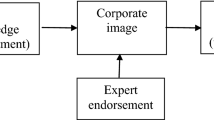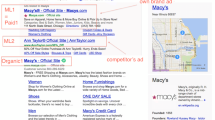Abstract
This research investigates the relationship between the utilization of various appeals in mutual fund advertisements and prevailing market, and regulatory conditions during the period 2000—2009. Mutual fund firms promote their investment products utilizing an array of advertising appeals, including those that highlight performance, product and consistency. We hypothesize that the application of these appeals varies over time and according to market conditions. In addition, the research considers the 2007 regulatory efforts mandating the inclusion of mutual fund expense information in advertisements that promote fund performance. A longitudinal content analysis is utilized to survey the presence and prevalence of various advertising appeals by mutual fund providers in Money magazine from 2000 to 2009. Results reveal that appeal usage varies over time and by market performance. Appeals focusing on performance and product are strongly correlated with market performance, whereas appeals relating to trust are correlated with subpar market performance. In addition, the use of cost information, broadly defined, has become more important over the 2000–2009 period independent of market performance. The implications of these findings and their relationship to government regulation are also discussed.
Similar content being viewed by others
References
Alexander, G.J., Jones, J.D. and Nigro, P.J. (1998) Mutual fund shareholders: Characteristics, investor knowledge, and sources of information. Financial Services Review 7 (4): 301–316.
Barber, B., Odean, T. and Zheng, L. (2005) Out of sight, out of mind: The effects of expenses on mutual fund flows. Journal of Business 78 (6): 2095–2119.
Capon, N., Fitzsimmons, G.J. and Prince, R.A. (1996) An individual level analysis of the mutual fund investment decision. Journal of Financial Services Research 10 (1): 59–82.
Chiang, K.H., Kozhevnikov, K. and Wisen, C.H. (2005) Ranking properties of morningstar risk-adjusted ratings. Journal of Investing 14 (1): 90–98.
Del Guercio, D. and Tkac, P.A. (2008) Star power: The effect of morningstar ratings on mutual fund flow. Journal of Financial and Quantitative Analysis 43 (4): 907–936.
Haslem, J.A. (2009) Investor learning and mutual fund advertising and distribution fees. Journal of Investing 18 (4): 53–56.
Houge, T. and Wellman, J. (2007) The use and abuse of mutual fund expenses. Journal of Business Ethics 70 (1): 23–32.
Huhmann, B.A. and Bhattacharyya, N. (2005) Does mutual fund advertising provide necessary investment information? International Journal of Bank Marketing 23 (4): 296–316.
Jain, P.C. and Wu, J.S. (2000) Truth in mutual fund advertising: Evidence on future performance and fund flows. The Journal of Finance 55 (2): 937–958.
Jones, M., Lesseig, V., Smythe, T. and Taylor, V. (2007) Mutual fund advertising: Should investors take notice? Journal of Financial Services Marketing 12 (3): 242–254.
Jones, M.A. and Smythe, T. (2003) The information content of mutual fund print advertising. Journal of Consumer Affairs 37 (1): 22–41.
Jordan, J. and Kaas, K. (2002) Advertising in the mutual fund business: The role of judgmental heuristics in private investor’s evaluation of risk and return. Journal of Financial Services Marketing 7 (2): 129–140.
Knuutila, M., Puttonen, V. and Smythe, T. (2007) The effect of distribution channels on mutual fund flows. Journal of Financial Services Marketing 12 (1): 88–96.
Korkeamaki, T., Puttonen, V. and Smythe, T. (2007) Advertising and mutual fund asset flows. International Journal of Bank Marketing 25 (7): 434–451.
Malkiel, B.G. (1995) Returns from investing in equity mutual funds 1971 to 1991. Journal of Finance 50 (2): 549–572.
Mutual Fund Factbook (2014) Investment Company Institute, May 14, 2014, 54th Edn.
Pontari, B., Stanaland, A. and Smythe, T. (2009) Regulating information disclosure in mutual fund advertising in the United States: Will consumers utilize cost information? Journal of Consumer Policy 32 (4): 333–351.
Yankow, J., Smythe, T., Lesseig, V. and Jones, M. (2011) The impact of advertising on fund flows in alternative distribution channels. International Journal of Financial Research 2 (1): 2–22.
Author information
Authors and Affiliations
Corresponding author
Additional information
1earned his PhD in Marketing from Virginia Tech, and earned both a MBA and a BS in Accounting from the University of Alabama. His primary research interest areas are globalization and international trade, and advertising issues in the financial services industry. His teaching areas include Consumer Behavior, Integrated Marketing Communication, International Marketing, Marketing Principles and Strategic Marketing Management.
2earned his PhD in Finance from the University of South Carolina, earned an MBA from George Mason University, and earned a BS in Mathematics from Furman University. His primary research interest areas are mutual funds and corporate governance. His teaching areas include Business Finance, Financial Markets Institutions and Investments.
3earned both her PhD and MS in psychology from the University of Florida, and a BA in psychology from Colgate University. Her primary research interest areas are self-presentation and impression management – or the process of conveying identities and images to others. Her teaching areas include General Psychology, Research Methods and Statistics, Social Psychology, and Perspective on Self and Identity.
4earned his Bachelor of Arts in Business Administration and Sociology summa cum laude at Furman University in 2012, where he was a member of Phi Beta Kappa and Alpha Kappa Delta. He is currently a JD Candidate ‘15 at Vanderbilt University Law School, where he is an Elliot E. Cheatham Scholar and serves as a Managing Editor on the Vanderbilt Law Review.
APPENDIX
APPENDIX
-
1
Affective (None/-): Advertisements that seek to arouse emotional feelings toward the mutual fund firm and/or product, often by emphasizing issues such as security and/or family values.
-
2
Consistency (None/-): Advertisements that communicate the ability of a fund or fund company to perform well over time. The appeal typically includes performance statistics covering multi-year periods (for example, 1 year, 5 year, 10 year).
-
3
Convenience (None): Advertisements that explicitly highlight how simple the firm makes investing for the investor, such as availability and access to special types of funds (for example, tax-free), ease of account access and access to personal service.
-
4
Cost (None/-): Advertisements that include any type of cost information, typically information relating to fees.
-
5
Dependability/Trust (-): Advertisements that highlight history, tradition and trustworthiness. Trustworthiness is often conveyed via advertisements that discuss a firm’s array of investment planning and guidance tools (for example, guides, online tools, personalized advisory services).
-
6
Expense ratio (None/-): Advertisements that explicitly list the expense ratio of a certain fund or funds.
-
7
Performance (+): Advertisements that contain specific past performance data shown either as a return percentage or in a graph.
-
8
Product (+): Advertisements that highlight and provide detailed information concerning a particular mutual fund or a select number of mutual funds within/across a specific investment area.
-
9
Product Portfolio (None/-): Advertisements that highlight a particular product or service that a mutual fund company offered that was not a mutual fund itself.
Rights and permissions
About this article
Cite this article
Underwood, R., Smythe, T., Pontari, B. et al. Advertising appeals across varying economic and regulatory conditions: A longitudinal content analysis in the mutual fund industry. J Financ Serv Mark 20, 162–175 (2015). https://doi.org/10.1057/fsm.2015.12
Received:
Revised:
Published:
Issue Date:
DOI: https://doi.org/10.1057/fsm.2015.12




